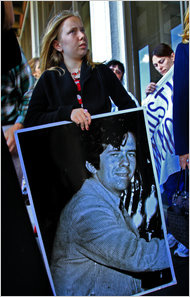
Haley Paisley, 10, with a photo of her uncle John McGraham, a mentally ill homeless man who was killed in Los Angeles. (Irfan Khan/Los Angeles Times, via Associated Press)
Killings of homeless people have risen to their highest level in a decade, with 43 people killed last year and many more injured in often brutal attacks that are raising concerns among law enforcement officials, rights advocates and politicians, according to new data due to be released this week.
The rise in killings, from 27 in 2008, comes as many state and local governments are wrestling with the problem of what to do with the growing number of people forced onto the streets by economic woes. Some states and cities are moving to prosecute violence against the homeless as a hate crime, while others have taken a different tack by imposing tougher measures to prevent people from living on the streets in the first place.
Cases compiled and analyzed by the National Coalition for the Homeless, an advocacy group based in Washington, showed homeless people doused with gasoline and set on fire, attacked with bottles, metal pipes and baseball bats, and sprayed with pepper spray, often for the sport of it. An advance copy of the report was provided to The New York Times.
Because the F.B.I. does not track crimes against the homeless as part of its routine crime reporting, the data from the coalition is considered the most definitive study of the problem. A bill pending in Congress from Senator Benjamin L. Cardin, Democrat of Maryland, would require the F.B.I. to begin tracking data on crimes against the homeless, and Mr. Cardin plans to lead a hearing next month in the Senate on the country's rising homeless problem, including violence against those living on the streets.
"The homeless are among our nation's most vulnerable, but increasingly they find themselves the target of violent crime simply because they are homeless," Mr. Cardin said. "This behavior should not and cannot be tolerated in our society."
Criminologists and others who worked on the study said they believed the rise in fatal attacks has been fueled by a combination of factors. Among them are tough economic times, the popularity of amateur Web videos on "bum fights" and on-line games that glorify and trivialize attacks, an increase in gang initiations involving the homeless, and municipal crackdowns on homeless encampments that have bred hostility.
"It's a very troubling trend," said Neil Donovan, executive director of the National Coalition for the Homeless. "We're seeing a level of hatred building to the point that it's deadly now."
The data on deadly attacks against the homeless runs counter to national trends in other areas of crime.
The F.B.I. reported in May that violent crime nationwide declined 5.5 percent last year from the year before. The data from the homeless coalition found that fatal attacks on the homeless rose 59 percent in that same time span, to 43. The number of fatalities last year was more than three times the number documented four years earlier and the highest number seen by the homeless coalition since 2000.
Brian Levin, a criminologist who assisted in the study and runs the Center for the Study of Hate and Extremism at California State University, San Bernardino, said the number of homeless people who died last year in attacks far exceeded the total of all other traditional, protected classes of hate crime victims, based on factors like gender, race and ethnicity.
Harassment and violence toward the homeless, many of them mentally ill, have become "pervasive and routine" in some sub-cultures, particularly among young men and teenagers, he said.
In an April 2009 case in Redding, Calif., that is included in the report, three teenage boys were accused of beating a homeless man to death and smashing his skull with metal pipes and makeshift bats after they had discussed a plan the day before at a local fast-food restaurant to beat up a "bum."
Since 1999, the coalition's report documented more than 1,000 acts of violence against homeless people, including 291 deaths, although the authors caution that many crimes against the homeless go unreported because of mistrust of the police.
Concerns about the violence have spurred legislative initiatives in a number of cities and states. Since May, Florida and Rhode Island have joined Maine and Maryland in passing legislation that expands protection for the homeless as hate crime victims, and the District of Columbia and Los Angeles County have done so as well. Seven other states, including California and New York, are considering similar measures.











